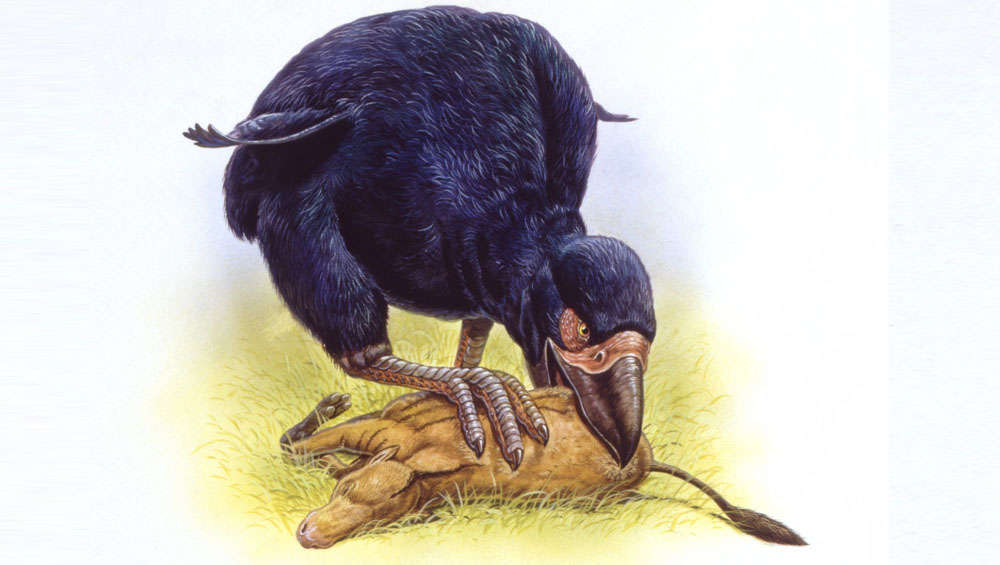Create a free profile to get unlimited access to exclusive videos, sweepstakes, and more!
Monstrous extinct bird had a squashed brain, because that happens when a beak takes up most of your head

If there was ever a creature that deserved one of those horror movie titles which starts with Attack of the Giant and ends with whatever species you’re going for, it was this prehistoric feathered monster that last roamed the wilds of Australia some 50,000 years ago.
Scary doesn’t begin to cover Dromornis stirtoni. At up to about 10 feet tall and 1,200 pounds, it was the most massive of the already huge flightless birds otherwise known as dromornithids or mihirungs (an Aboriginal word for “giant bird”), but its brain might have been the freakiest thing of all. Few dromornithid skulls have been found despite the size of these things. Even without many fossils, new research has shown these extinct Cenozoic birds had really bizarre brains.
Spoiler: unlike the vicious rendering above, which goes to show just how little we know about them, these birds had more of a taste for fruit than flesh. They probably also looked more like this.
Dromornithids are some of the largest birds whose thunderous footsteps ever shook the Earth. That they had huge heads shouldn’t be shocking, but with their powerful beaks taking up so much real estate, their brains ended up being squished into a cranium whose height and width went far beyond its length. Paleontologist Warren Handley, who recently led a study published in Diversity, saw this phenomenon up close. Such a brain was far off from related extant birds in some ways — but not so different in others.
“The top part of the brain, an area called the wulst, is very much expanded in dromornithids, but this area is much smaller in their extant relatives,” Handley told SYFY WIRE. “However, they share very similar characteristics of the middle and hindbrain, as well as the shape of the nerves that connect to taste and touch receptors in their bills, with their extant relatives.”
Handley believes that the similarities between dromornithids and their surviving relatives, galliforms like chickens and turkeys, are probably evidence that the monster birds used the same, similarly shaped parts of their brains in ways that were not too far apart. They were previously mistaken for ratites. These flightless birds are missing the keel on the breastbone that enables flight, like the also extinct giant elephant birds of Madagascar, Vorombe titan.
What mihirung brains looked like was determined by CT scans that showed the bony structures inside the skull. The brain and nerves — because nerves get into the skull and brain through bony channels — could then be digitally reconstructed in 3D. This is what revealed that the brains of D. stirtoni and its brethren were so weirdly shaped. Virtual models of these bird brains gave away the main difference between them and their descendants, and also gave insight into their sensory perception.
The wulst is a brain bulge only found in birds. This protuberance, which functions like the human isocortex, is associated with sensory perception, meaning an enlarged wulst in dromornithids probably helped them see their surroundings much better than any chicken. They weren’t actually much scarier than chickens. Despite the imposing size of mihirungs, they weren’t a threat to anything except whatever they might have accidentally stomped on. Their Godzilla looks are deceptive because they actually weren’t predators.
“We think dromornithids primarily used their large forward facing eyes and excellent depth perception for precise feeding on soft leaves and fruit in forested environments,” Handley said. “They may also have used depth perception for feeding their chicks with their large bills too, and certainly would have used their superb visual abilities for moving through the complex forests they lived in.”
Much about mihirungs still eludes us. Their strange biology is just now being studied in more depth, and this is the first time anyone has virtually dissected their brains. The problem is that there is a gap in the fossil record. Dromornithids go back at least 25 million years, and even their oldest fossils are so unique that they cannot be mistaken for anything else. So why does it seem they vanished for eons? Handley believes that the bones of many dromornithid ancestors have just not emerged yet.
“There must have been a long ‘ghost lineage’ of birds that evolved into the dromornithid form we know today, but which are invisible to us because they weren’t preserved as fossils, or, we simply haven’t found them yet,” he said. “There are many discoveries yet to be made.”
Dromornis stirtoni still ought to be the star of its own movie. Maybe the humans will finally stop screaming after they see it going for a fruit truck when it gets hungry.


























